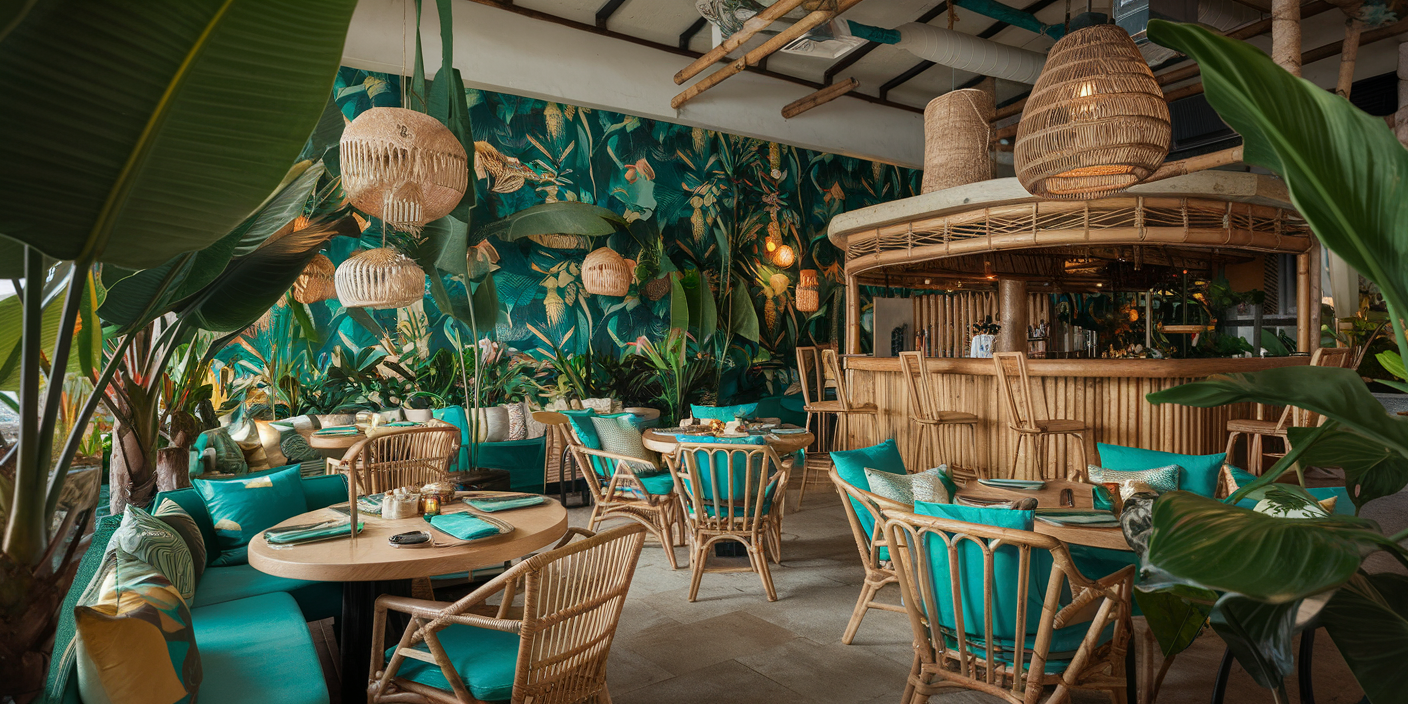Transforming a restaurant into a tropical oasis offers diners an escape from the ordinary into an exotic paradise. Tropical restaurant design blends lush natural elements, vibrant colors, and authentic materials to create immersive dining experiences that transport guests to faraway destinations. This comprehensive guide explores how to create stunning tropical interiors that engage all the senses while providing practical design solutions for restaurant owners.




Essential Elements of Tropical Restaurant Design
Natural Materials as Foundation
The cornerstone of authentic tropical design begins with natural materials:
- Bamboo: Lightweight yet durable, perfect for structural elements, room dividers, bar fronts, and furniture
- Rattan and Wicker: Ideal for seating, light fixtures, and decorative elements that add texture
- Teak and Acacia Wood: Rich, warm woods that withstand commercial use while providing authentic tropical character
- Stone and Pebbles: Bring organic texture to flooring, accent walls, and water features
- Tropical Hardwoods: Sustainable options like mango wood for tables, countertops, and architectural details
Vibrant Color Palette
Tropical design embraces color psychology to create specific moods:
- Ocean Blues and Turquoise: Create a sense of water and tranquility
- Lush Greens: Connect interiors with tropical foliage
- Sunset Oranges and Yellows: Add warmth and energy
- Botanical Pinks and Purples: Introduce exotic flower tones for accent pieces
- Neutrals: Sand, ivory, and natural wood tones that balance brighter colors
The most effective tropical interiors layer these colors strategically rather than using them all equally.
Signature Furniture Pieces
Select furniture that balances tropical aesthetics with commercial durability:
- Fan-Back Peacock Chairs: Statement seating that creates focal points
- Low-Slung Lounge Areas: Create relaxed, resort-style spaces for cocktails
- Carved Wood Tables: Showcase craftsmanship with tropical motifs
- Bamboo Bar Stools: Lightweight yet sturdy seating at bars and high-top tables
- Booth Seating with Botanical Upholstery: Combine comfort with tropical patterns
Strategic Lighting Design
Lighting significantly impacts the tropical atmosphere:
- Pendant Lights with Natural Materials: Bamboo, rattan, or woven grass fixtures
- Warm Ambient Lighting: Creating a sunset-like glow throughout
- Subtle Uplighting on Plants: Highlighting botanical elements
- Candles and Tiki Torches: For authentic flickering light
- String Lights: Creating a starry effect for evening dining
Incorporating Lush Greenery
Plants transform tropical restaurant interiors from themed spaces to living environments:
- Statement Trees: Large palms or ficus trees as focal points
- Hanging Plants: Creating visual layers with ferns and trailing species
- Living Walls: Vertical gardens that maximize greenery in limited space
- Potted Tropical Plants: Strategically placed bird of paradise, monstera, and philodendrons
- Fresh Flowers: Rotating displays of tropical blooms like orchids, heliconia, and ginger
Select a mix of real and high-quality artificial plants for areas where maintenance may be challenging.
Creating Distinctive Zones
Effective tropical restaurant layout often includes several atmospheres:
- Indoor/Outdoor Integration: Blurring boundaries with folding glass walls
- Bar Area: Often more energetic with signature tropical cocktails
- Main Dining Space: Arranged for both intimate and group dining
- Private Dining Alcoves: Secluded spaces surrounded by greenery
- Outdoor Patios: Extended dining under the sky with appropriate weather protection
Ceiling and Wall Treatments
Overhead and vertical surfaces offer opportunities for tropical impact:
- Exposed Thatch or Palm Leaf Ceilings: Creating authentic overhead texture
- Wooden Slat Walls: Providing natural warmth and acoustic benefits
- Botanical Wallpaper: Making bold statements with large-scale tropical prints
- Rattan Ceiling Panels: Adding texture while concealing mechanical systems
- Water Features: Creating movement and soothing sounds
Authentic Décor Elements
Carefully selected accessories complete the tropical transformation:
- Vintage Travel Posters: Celebrating tropical destinations
- Carved Masks and Artifacts: Adding cultural dimension when respectfully sourced
- Nautical Elements: Rope details, weathered wood, and marine accents
- Ceiling Fans: Both functional and aesthetically appropriate
- Natural Fabric Curtains: Linen or cotton panels that move with the breeze
Regional Tropical Styles
Consider drawing inspiration from specific tropical regions:
- Caribbean: Colorful shutters, rum barrel accents, and island-inspired patterns
- Southeast Asian: Buddha figures, silk textiles, and ornate carved details
- Polynesian: Tiki elements, tribal patterns, and outrigger canoe motifs
- Brazilian Tropical: Modernist influences with jungle elements
- Coastal Mediterranean: Whitewashed walls with bright blue accents and lush greenery
Practical Considerations for Restaurant Owners
Balance tropical aesthetics with operational realities:
- Easy-to-Clean Surfaces: Select materials that withstand commercial cleaning protocols
- Durability: Choose commercial-grade fabrics with tropical patterns
- Noise Management: Incorporate acoustic solutions disguised as tropical elements
- Temperature Control: Consider airflow and comfort in lush, plant-filled environments
- Maintenance Planning: Develop systems for plant care and décor upkeep
Conclusion
A successful tropical restaurant interior creates an immersive escape that engages all senses while providing practical functionality for staff and comfort for guests. By thoughtfully incorporating natural materials, vibrant colors, lush plants, and authentic details, restaurant owners can create distinctive dining environments that transport guests to exotic destinations.
The key to effective tropical design lies in creating authentic atmospheres rather than themed caricatures—spaces that feel like genuine tropical havens where the experience extends beyond the plate to encompass the entire environment. When executed properly, tropical restaurant design creates memorable dining experiences that keep guests returning for both the food and the atmosphere.


Leave a Reply